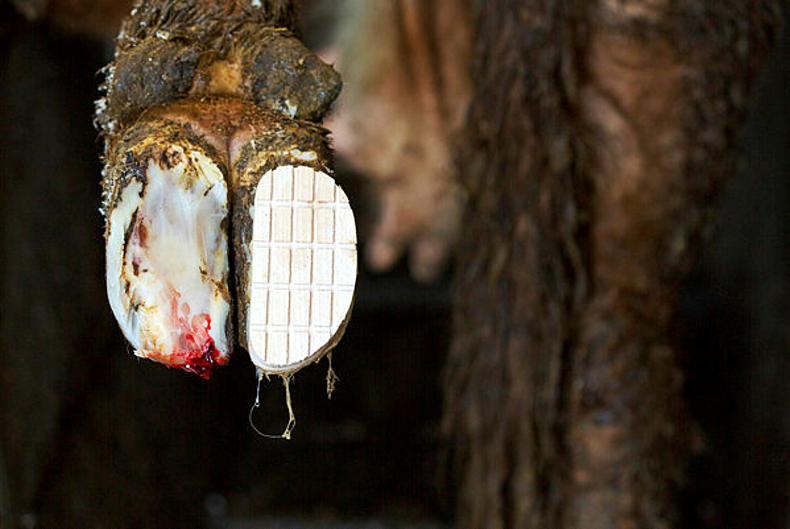This disease is caused by treponeme bacteria and is highly contagious if environmental conditions are suitable. Digital dermatitis is most commonly found in association with excessive build-up of slurry in collecting yards, housing and walkways. As these environmental conditions are also favourable for anaerobic bacteria such as fusobacterium and bacteroides, digital dermatitis is often found in association with other common causes of lameness eg footrot, foot abscesses and white line disease. However, it is spread from cow to cow unlike the other forms of lameness.
Symptoms
Mortellaro’s digital dermatitis is a painful condition and badly affected animals will be obviously lame. In severe cases, animals may stand with the toe barely touching the ground. Affected animals will have an arched back both standing and while walking. The most important thing to remember is that the lesion caused by these treponeme bacteria is found only on the skin or the coronary band. Mortellaro’s digital dermatitis does not affect the horn of the hoof. The classic location of the digital dermatitis lesion is on the skin just above the bulbs of the heel. It is a raw, ulcerative lesion, in most cases, which leads to the marked pain associated with this condition. In some chronic, long-standing cases, hair-like growths of keratin can be seen protruding from the affected tissue giving it the name “hairy wart”. Similar ulcerative lesions can be found on the skin just above the junction of the claws in the front of the foot. Ulcerative lesions can also be found on the coronary band (the tissue at the skin-horn junction from which the horn grows) and, if they are severe enough, they can affect horn growth with the formation of vertical cracks and fissures in the hoof horn.
Treatment
Treatment involves clearing any faecal material or dried bedding off the lesion, followed by the application of topical oxytetracycline spray. In severe cases, it is advisable to treat using systemic antibiotics (eg ceftiofur, oxytetracycline or tylosin). Footbathing is also a crucial component to treatment as well as control and prevention. Traditionally, it had been found that the antibiotic footbaths, such as lincomycin and oxytetracycline, were most efficacious in the treatment of digital dermatitis. However, recent research has shown that 5% copper sulphate may actually be more beneficial, as well as providing a cheaper alternative without the use of antibiotics. Best results are definitely obtained when footbathing is carried out on clean feet, ie the cows’ feet should either be hosed down as they leave the parlour or they should walk through a waterbath prior to entry into the footbath containing 5% copper sulphate or antibiotic. In severe cases, cows should be walked through a footbath daily for four days and then maintained on a once weekly regime.
Prevention and control
Mortellaro’s digital dermatitis should be controlled on a whole-herd basis, particularly where disease is prevalent. Maintaining as clean an environment as possible is an important step in maximising claw health. In affected herds, cows should be footbathed, as described previously (see page 37), once weekly until disease prevalence decreases. It is advisable to carry out locomotion scoring on the herd three to four times a year, if possible, to ascertain the level of lameness in the herd, and to treat individual lame cows as early as possible. Remember, this is a contagious disease, transmissible through contaminated faeces, and that it can be introduced into a herd by the purchase of an infected animal. Therefore, biosecurity is again crucial to prevention of this disease, especially as mildly affected animals may not show obvious lameness.






 This is a subscriber-only article
This is a subscriber-only article








SHARING OPTIONS: